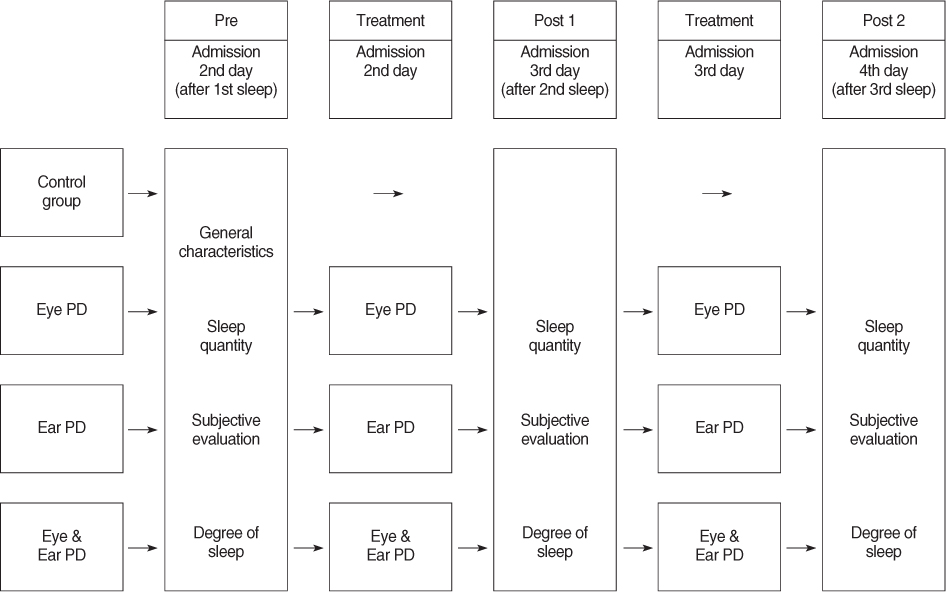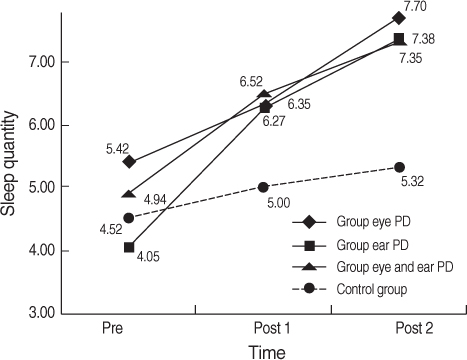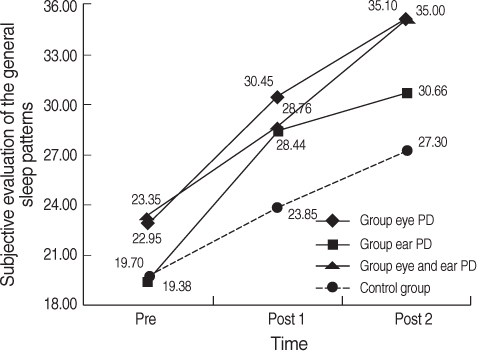J Korean Acad Nurs.
2008 Aug;38(4):582-592. 10.4040/jkan.2008.38.4.582.
Effects of Eye Protective Device and Ear Protective Device Application on Sleep Disorder with Coronary Disease Patients in CCU
- Affiliations
-
- 1Department of Nursing, Andong Science College, Andong, Korea. lice1@kmu.ac.kr
- 2College of Nursing, Keimyung University, Daegu, Korea.
- KMID: 820112
- DOI: http://doi.org/10.4040/jkan.2008.38.4.582
Abstract
- PURPOSE: The purpose of this research was to analyze the effects of an eye protective device and ear protective device application on sleep disorder with coronary disease patients in CCU. METHODS: The research design was set up as a nonequivalent control group non-synchronized design. The subjects were coronary disease patients in the CCU of a tertiary hospital. The subjects were composed of 20 in the group with an eye protective device, 18 in the group with an ear protective device, 17 in the group with an eye protective device and ear protective device and 20 in the control group. The data was analyzed by chi-square-test, ANOVA, Repeated measures ANOVA, Sheffe-test, Simple main effect and Time contrast using SPSS Win 12.0. RESULTS: The hypothesis, 'There are significant differences in sleep quantity among the four groups' was supported (F=1,342.71, p=.000). The hypothesis, 'There are significant differences in the subjective evaluation of the general sleep patterns among the four groups' was supported (F=3,638.73, p=.000). In addition the hypothesis, 'There are significant differences in degree of sleep among the four groups' was supported (F=1,616.61, p=.000). CONCLUSION: It is cost effective and a simple eye protective device and ear protective device should be applied to patients according to their preference and characteristics in the clinical setting.
MeSH Terms
Figure
Reference
-
1. Bently S, Murphy F, Ellis BW, Dudley D. Sleep deprivation in patients undergoing operation: A factor in stress of surgery. British Medical Journal. 1977. 10:1521–1522.2. Beyerman K. Etiologies of sleep pattern disturbance in hospitalized patients. Classifications of Nursing Diagnosis: Proceeding of the Seventh Conference. 1987. St. Louis: Mosby.3. Byers JF, Smyth KA. Effect of a music intervention on noise annoyance, heart rate, and blood pressure in cardiac surgery patients. American Journal of Critical Care. 1997. 6:183–191.
Article4. Cohen J. Statistical power analysis for behavioral science. 1988. New York: Academic Press.5. Foreman MD, Wykle M. Nursing standard of practice protocol: Sleep disturbances in elderly patients. The NICHE Faculty. Geriatric Nursing. 1995. 16:238–243.6. Fox MR. The importance of sleep. Nursing Standard. 1999. 13(24):44–47.
Article7. Freedman NS, Kotzer N, Schwab RJ. Patient perception of sleep quality and etiology of sleep disruption in the intensive care unit. American Journal of Respiratory and Critical Care Medicine. 1999. 159(4, Pt 1):1155–1162.
Article8. Haddock J. Reducing the effects of noise in hospital. Nursing Standard. 1994. 8(43):25–28.
Article9. Hwang EH. Effects of hand acupuncture therapy on sleep quality in sleep disrupted adults: Verification by polysomnography and cerebral blood flow test. Journal of Korean Academy of Nursing. 2007. 37:1108–1118.
Article10. Jung HW. A comparative study on noise level and nurses' degree of noise perception in general hospital. Korean Journal of Occupational Health Nursing. 2001. 10:174–182.11. Kahn DM, Cook TE, Carlisle CC, Nelson DL, Kramer NR, Millman RP. Identification and modification of environmental noise in an ICU setting. Chest. 1998. 114:535–540.
Article12. Kim KH. Quality of sleep and sleep disturbance factors of coronary artery disease patients in CCU. 2001. Seoul: Ehwa Womans University;Unpublished master's thesis.13. Kim MA. A study on the sleep amount of patient and environmental factors influencing to the sleep amount in intensive care unit. 1986. Seoul: Seoul National University;Unpublished master's thesis.14. Kim MJ. Effects of earplugs application on the noise-induced disturbed sleep patterns in ICU patients. 2003. Daegu: Keimyung University;Unpublished master's thesis.15. Kim MY, Cho SH, Lee SM, Jung SJ, Park KS. Elderly sleep pattern and disturbing factors before and after hospitalization. Journal of Korean Academy of Nursing. 1999. 29:61–71.
Article16. 2003's Mortality according to Cause of Death. 2004. December. 18. Retrieved March 2, 2005. Korean National Statistical Office;from http://kosis.nso.go.kr/juro/index.html.17. Lee YH, Kim JS. A study on sleep deprivation factors and its influence of patients that hospitalized in general ward. Central Medical Association. 1996. 61(12):96.18. Masahiro T. The lighting plan a patient peacefulness. Journal of Illuminating Engineering Institute of Japan. 2004. 88:675–681.19. Oh JJ, Song MS, Kim SM. Development and validation of Korean sleep scale A. Journal of Korean Academy of Nursing. 1998. 28:563–572.20. Pacini CM, Fitzpatrick JJ. Sleep pattern of hospitalized and non-hospitalized aged individuals. Journal of Gerontological Nursing. 1982. 8:327–332.21. Parish JM, Shepard JW Jr. Cardiovascular effects of sleep disorder. Chest. 1990. 97:1220–1226.22. Park EJ. The effect of auricular acupressure on sleep, serotonin, TNF-α & IL-6 of hemodialysis patients. 2007. Jinju: Gyeongsang National University;Unpublished doctoral dissertation.23. Redeker NS. Sleep in acute care setting: An integrative review. Image-The Journal of Nursing Scholarship. 2000. 32:31–38.24. Redeker NS, Tamburri L, Howland CL. Prehospital correlates of sleep in patients hospitalized with cardiac disease. Research in Nursing & Health. 1998. 21:27–37.
Article25. Schwab RJ. Disturbances of sleep in the intensive care unit. Critical Care Clinics. 1994. 10:681–694.
Article26. Son YJ. The relationship between noise and sleep pattern in intensive care unit. 1999. Seoul: Yonsei University;Unpublished master's thesis.27. Song RH. The effect of foot reflexo-massage on the sleep, depression and physiological index of elderly. 2004. Daejeon: Chungnam National University;Unpublished doctoral dissertation.28. Southwell MT. In-patient sleep disturbance: The views of staff and patients. Journal of Advanced Nursing. 1995. 18:521–529.29. Tae YS, Baek JH. Related factors of sleep of adult patients in hospital. Kosin Medical Journal. 2003. 18:112–127.30. Topf M, Bookman M, Arand D. Effects of critical care unit noise on the subjective quality of sleep. Journal of Advanced Nursing. 1996. 24:545–551.
Article
- Full Text Links
- Actions
-
Cited
- CITED
-
- Close
- Share
- Similar articles
-
- Evaluation of the Protective Effect of an Ophthalmic Viscosurgical Device on the Ocular Surface in Dry Eye Patients during Cataract Surgery
- Can Fitness Trackers Track Sleep?
- Comparison of Post-Health Care of Workers with Noise Induced Hearing Loss between Medium Sized Industries and a Large Automobile Industry
- Severe edema of the eyes and lips as rare side effects of eye ointment for protection of eyes under general anesthesia: A case report
- Long-Term Side Effects of Mandibular Advancement Devices in Patients with Obstructive Sleep Apnea





